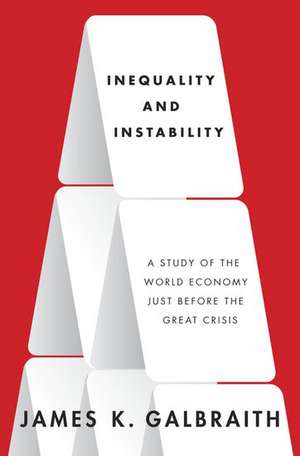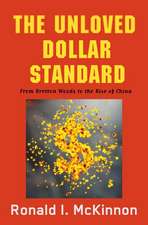Inequality and Instability: A Study of the World Economy Just Before the Great Crisis
Autor James K. Galbraithen Limba Engleză Hardback – 3 mai 2012
The dominant voices among academic economists were unable to interpret the causal forces at work during both the Great Depression and the recent global financial crisis. In Inequality and Instability, James K. Galbraith argues that since there has been no serious work done on the macroeconomic effects of inequality, new sources of evidence are required. Galbraith offers for the first time a vast expansion of the capacity to calculate measures of inequality both at lower and higher levels of aggregation.
Instead of measuring inequality as traditionally done, by country, Galbraith insists that to understand real differences that have real effects, inequality must be examined through both smaller and larger administrative units, like sub-national levels within and between states and provinces, multinational continental economies, and the world. He points out that inequality could be captured by measures across administrative boundaries to capture data on more specific groups to which people belong. For example, in China, economic inequality reflects the difference in average income levels between city and countryside, or between coastal regions and the interior, and a simple ratio averages would be an indicator of trends in inequality over the country as a whole. In a comprehensive presentation of this new method of using data, Inequality and Instability offers an unequaled look at the US economy and various global economies that was not accessible to us before. This provides a more sophisticated and a more accurate picture of inequality around the world, and how inequality is one of the most basic sources of economic instability.
Readership: Undergraduate and graduate students, and professors of economic inequality, comparative economics, econometric research, economic history, economic theory, and global finance. Educated professionals and experts of the 2008 global financial crisis.
Preț: 174.43 lei
Preț vechi: 198.54 lei
-12% Nou
Puncte Express: 262
Preț estimativ în valută:
33.38€ • 35.69$ • 27.83£
33.38€ • 35.69$ • 27.83£
Carte tipărită la comandă
Livrare economică 07-12 aprilie
Preluare comenzi: 021 569.72.76
Specificații
ISBN-13: 9780199855650
ISBN-10: 019985565X
Pagini: 336
Ilustrații: 59 black and white line drawings
Dimensiuni: 236 x 163 x 25 mm
Greutate: 0.61 kg
Editura: Oxford University Press
Colecția OUP USA
Locul publicării:New York, United States
ISBN-10: 019985565X
Pagini: 336
Ilustrații: 59 black and white line drawings
Dimensiuni: 236 x 163 x 25 mm
Greutate: 0.61 kg
Editura: Oxford University Press
Colecția OUP USA
Locul publicării:New York, United States
Recenzii
an astoundingly broad, illuminating, and detailed examination of the global rise in income inequality between 1980 to the dawn of the financial crisis in 2008...Galbraith boldly brings the problem of radical inequality from the margins to the centre of economic analysis.
A truly pathbreaking work of scholarship.
A must-read for anyone who wishes to understand our political and economic era.
James K. Galbraiths ^
A truly pathbreaking work of scholarship.
A must-read for anyone who wishes to understand our political and economic era.
James K. Galbraiths ^
Notă biografică
James K. Galbraith, Lloyd M. Bentsen Jr. Chair in Government/Business Relations and Professor of Government, University of Texas at Austin
James K. Galbraith is the Lloyd M. Bentsen Jr. Chair in Government/Business Relations and Professor of Government at the LBJ School of Public Affairs at the University of Texas. He is the author most recently of The Predator State: How Conservatives Abandoned the Free Market and Why Liberals Should Too (Free Press, 2009, $25 cloth, $15 pbk, 18,127 combined RTD Bookscan)
Cuprins
Chapter 1. The Physics and Ethics of Inequality
1. The Simple Physics of Inequality Measurement
2. The Ethical Implications of Inequality Measures
3. Plan of the Book References
Chapter 2. The Need for New Inequality Measures
1. The Data Problem in Inequality Studies
2. Obtaining Dense and Consistent Inequality Measures
3. Grouping Up and Grouping Down
4. Conclusion References
Chapter 3: Pay Inequality and World Development 1. What Kuznets Meant 2. New Data for a New Look at Kuznets' Hypothesis 3. Pay Inequality and National Income: What's the Shape of the Curve? 4. Global Rising Inequality: the Soros Super-bubble as a Pattern in the Data 5. Conclusion References Appendix: On a Presumed Link from Inequality to Growth Chapter 4. Estimating the Inequality of Household Incomes 1. Estimating the Relationship Between Inequalities of Pay and Income 2. Finding the Problem Cases: A Study of Residuals 3. Building a Deep and Balanced Income Inequality Data Set 4. Conclusion References Chapter 5. Economic Inequality and Political Regimes 1. Democracy and Inequality in Political Science 2. A Different Approach to Political Regime Types 3. Analysis and Results 4. Conclusion References Appendix I: Political Regime Data Description Appendix II: Results Using Other Political Classification Schemes Chapter 6. The Geography of Inequality in America, 1969 to 2007 1. Between-Industry Earnings Inequality in the United States 2. The Changing Geography of American Income Inequality 3. Interpreting Inequality in the United States 4. Conclusion References Chapter 7: State-Level Income Inequality and American Elections 1. Some Initial Models Using Off-the-Shelf Data for the 2000 Election. 2. New Estimates of State-Level Inequality and an Analysis of the Inequality-Elections Relationship over Time 3. Inequality and the Income Paradox in Voting 4. Conclusion References Chapter 8. Inequality and Unemployment in Europe: A Question of Levels 1. An Inequality-based Theory of Unemployment 2. Region-based Evidence on Inequality and Unemployment 3. Inequality and Unemployment in Europe and America 4. Implications for Unemployment Policy in Europe References Appendix. Detailed Results and Sensitivity Analyses Chapter 9. European Wages and the Flexibility Thesis 1. The Problem of Unemployment in Europe: A reprise 2. Assessing Wage Flexibility Across Europe 3. Clustering and Discriminating to Simplify the Picture 4. Conclusion References Appendix A: Cluster Details Appendix B: Eigenvalues and Canonical Correlations Appendix C: Correlations between Canonical Scores and Pseudoscores Chapter 10: Globalization and Inequality in China 1. The Evolution of Inequality in China through 2007 2. Finance and the export boom, 2002 to 2006 3. Trade and capital inflow in post-WTO China 4. Profit and Capital Flows into Speculative Sectors 5. Conclusion References Chapter 11. Finance and Power in Argentina and Brazil 1. The Modern Political Economy of Argentina and Brazil 2. Measuring Inequality in Argentina and Brazil 3. Sources of Data 4. Pay Inequality in Argentina 1994-2007 5. Pay Inequality in Brazil 1996-2007 6. Conclusion References Chapter 12. Inequality in Cuba After the Soviet Collapse 1. Data on Pay in Cuba 2. Evolution of the Cuban Economy 1991 - 2005 3. Cuban Pay Inequality by Sector 4. Cuban Pay Inequality by Region 5. Conclusion References Chapter 13: Economic Inequality and the World Crisis Bibliography
1. The Simple Physics of Inequality Measurement
2. The Ethical Implications of Inequality Measures
3. Plan of the Book References
Chapter 2. The Need for New Inequality Measures
1. The Data Problem in Inequality Studies
2. Obtaining Dense and Consistent Inequality Measures
3. Grouping Up and Grouping Down
4. Conclusion References
Chapter 3: Pay Inequality and World Development 1. What Kuznets Meant 2. New Data for a New Look at Kuznets' Hypothesis 3. Pay Inequality and National Income: What's the Shape of the Curve? 4. Global Rising Inequality: the Soros Super-bubble as a Pattern in the Data 5. Conclusion References Appendix: On a Presumed Link from Inequality to Growth Chapter 4. Estimating the Inequality of Household Incomes 1. Estimating the Relationship Between Inequalities of Pay and Income 2. Finding the Problem Cases: A Study of Residuals 3. Building a Deep and Balanced Income Inequality Data Set 4. Conclusion References Chapter 5. Economic Inequality and Political Regimes 1. Democracy and Inequality in Political Science 2. A Different Approach to Political Regime Types 3. Analysis and Results 4. Conclusion References Appendix I: Political Regime Data Description Appendix II: Results Using Other Political Classification Schemes Chapter 6. The Geography of Inequality in America, 1969 to 2007 1. Between-Industry Earnings Inequality in the United States 2. The Changing Geography of American Income Inequality 3. Interpreting Inequality in the United States 4. Conclusion References Chapter 7: State-Level Income Inequality and American Elections 1. Some Initial Models Using Off-the-Shelf Data for the 2000 Election. 2. New Estimates of State-Level Inequality and an Analysis of the Inequality-Elections Relationship over Time 3. Inequality and the Income Paradox in Voting 4. Conclusion References Chapter 8. Inequality and Unemployment in Europe: A Question of Levels 1. An Inequality-based Theory of Unemployment 2. Region-based Evidence on Inequality and Unemployment 3. Inequality and Unemployment in Europe and America 4. Implications for Unemployment Policy in Europe References Appendix. Detailed Results and Sensitivity Analyses Chapter 9. European Wages and the Flexibility Thesis 1. The Problem of Unemployment in Europe: A reprise 2. Assessing Wage Flexibility Across Europe 3. Clustering and Discriminating to Simplify the Picture 4. Conclusion References Appendix A: Cluster Details Appendix B: Eigenvalues and Canonical Correlations Appendix C: Correlations between Canonical Scores and Pseudoscores Chapter 10: Globalization and Inequality in China 1. The Evolution of Inequality in China through 2007 2. Finance and the export boom, 2002 to 2006 3. Trade and capital inflow in post-WTO China 4. Profit and Capital Flows into Speculative Sectors 5. Conclusion References Chapter 11. Finance and Power in Argentina and Brazil 1. The Modern Political Economy of Argentina and Brazil 2. Measuring Inequality in Argentina and Brazil 3. Sources of Data 4. Pay Inequality in Argentina 1994-2007 5. Pay Inequality in Brazil 1996-2007 6. Conclusion References Chapter 12. Inequality in Cuba After the Soviet Collapse 1. Data on Pay in Cuba 2. Evolution of the Cuban Economy 1991 - 2005 3. Cuban Pay Inequality by Sector 4. Cuban Pay Inequality by Region 5. Conclusion References Chapter 13: Economic Inequality and the World Crisis Bibliography








